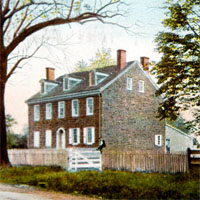This 45-portrait proof sheet of Narberth Public School children is filed in the Lower Merion Historical Society's archive. Which grade are they in? What year is it? Their age, according to the wisdom of crowds (the average of 20 answers): 7.8 years old. Dental forensics confirm that top front incisors loosen at age 6-7, lateral incisors at 7-8, both of which we see. Finally (maybe this should have come first), the photo was accompanied by a list naming 22. According to the 1920 census, all were 6-8 years old, first and second grade, in 1916.
Narberth Public School: Its History in a Nutshell

The Narberth Public School building attended by these children was constructed on the corner of Sabine and Essex in 1892 by Lower Merion. It was transferred to the new borough with its newly independent school district in 1895. A second building was added to its east in 1917. High school classes were offerred from 1909 to 1923, then transferred to Lower Merion. Our students were then sophomores or juniors, so they did not get to graduate in their home town.

Both buildings were demolished in 1961 and replaced by the current building at this location in 1963. In 1968 the Narberth school district was merged back into Lower Merion, which closed Narberth Public School in 1978 due to declining enrollment.
Family albums




Missing names
23 of these children are not named on the note that accompanies the photo. Can we ever discover their identities?

Consider the pair that share the same expression and eyewear: if they are brother and sister, and if they lived in Narberth and if they were counted in the 1910 or 1920 census, they could be Dolores Durang, age 7, and Edwin, six in 1916. The Durangs moved to St. Davids by 1920. Or they might be Dorothy Thornley, 8, and John, 6, from the 1920 census. A lot of ifs…

Altogether, there were 235 children in Narberth in the 1920 census who would be the right age to appear in the photo. Lacking a personal memory, a contemporary document or some connection to those days, we can only guess at their names.
“Their Happy Faces”
The final word belongs to the unattributed Our Town correspondent, perhaps a proud parent, who reported the 1916 school commencement:
The first grade was first called. What an applause burst forth from the student body! Everybody realized this was the last time the little ones of the first grade should please them with their happy faces and splendid reciting as "first graders." The principal seemed to realize this more than any one. He has always shown a particular love for the wee tots. At the call of each individual's name, one after the other arose amidst hearty applause. The grade then quoted appropriate lines from Lowell's Vision of Sir Launfal and passed into the mysteries of second gradehood.

References
- "Commencement Week a Great Success", Our Town June 22, 1916, page 5 (PDF)
- "What is so rare as a day in June?" —James Russell Lowell, The Vision of Sir Launfal (1848)
- Public Schools in Lower Merion and Narberth, Lower Merion Historical Society
- Ted Goldsborough interviewed two Narberth Public School alumni who attended school in the 1950s in the buildings these children knew in four 12-minute videos at the Lower Merion Historical Society.
The Lower Merion Historical Society has preserved Narberth High School's 1920 yearbook, and several issues of the the 1930s – 1950s school newspaper, The Sundial.
Updated July 18, 2025.











































































